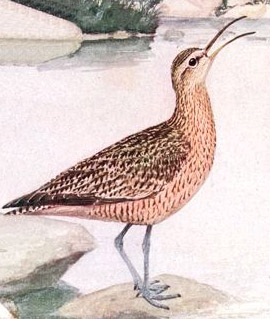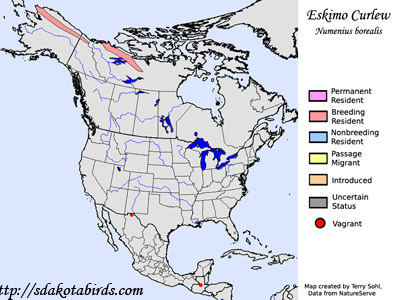| Length: 12 to 14 inches | Wingspan: 24 to 26 inches | Seasonality: Migrant |
| ID Keys: Slender decurved bill, dark brown crown with buff spots and edging, buffy supercilium | ||
 Once possibly among the
most numerous of shorebirds to migrate through the Great Plains, the Eskimo
Curlew is now feared extinct.
Highly sought after in the 1800's as a game-bird because of their plump bodies,
vast numbers were shot for food. While other shorebirds began to make a
comeback after hunting stopped, Eskimo Curlews continued to decline. The
last verified sighting was in Barbados in 1963. Very similar to the
story of the Ivory-billed Woodpecker, however, unconfirmed reports have
continued to trickle in since. An intriguing sighting came from a
well-respected ornithologist in 2006 on the coast of Nova Scotia, but no
photo or other proof was obtained.
Once possibly among the
most numerous of shorebirds to migrate through the Great Plains, the Eskimo
Curlew is now feared extinct.
Highly sought after in the 1800's as a game-bird because of their plump bodies,
vast numbers were shot for food. While other shorebirds began to make a
comeback after hunting stopped, Eskimo Curlews continued to decline. The
last verified sighting was in Barbados in 1963. Very similar to the
story of the Ivory-billed Woodpecker, however, unconfirmed reports have
continued to trickle in since. An intriguing sighting came from a
well-respected ornithologist in 2006 on the coast of Nova Scotia, but no
photo or other proof was obtained.
Habitat: Nests on the Arctic tundra. In winter and migration, could be found on open areas such as agricultural fields and grasslands.
Diet: Insects, some fruits and berries.
Breeding: Non-breeder in South Dakota
Song: Soft high-pitched squeaks and whistles.
Migration: Breeds in northwestern Canada and Alaska. Winters in South America.
Interactive eBird Map: Click here to access an interactive eBird map of Eskimo Curlew sightings
Similar Species: Whimbrel
Conservation Status: Possibly extinct, with no verified sightings since 1963, but with several unconfirmed reports since then.
Further Information: 1) Alaska Fish And Game Profile - Eskimor Curlew
3) BirdLife International - Eskimo Curlew
Photo Information: Painting by Louis Agassiz Fuertes
| Click on the map below for a higher-resolution view |
 |
| South Dakota Status: Possibly extinct. Once migrated through the state. |
